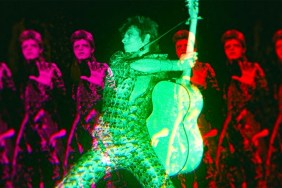
Sound SHOCK re-reads Bowie’s classic video “Ashes to Ashes” as a surrealist horror film.
Strung Out in Heaven’s High
– David Bowie’s Ashes to Ashes
As we continue to reflect on the vast legacy of this extraordinary artist, come with me back to one of David Bowie’s most memorable videos – ‘Ashes to Ashes’ from 1980.
It is one of the most powerful horror films I have ever seen.
The song was a number one hit in the UK charts. The video was, at that time, the most expensive ever made. It was an event. As a result it seemed to crop up on television all the time. For my eight year old self this was an overwhelming and haunting assault on the senses. I shivered when I heard those initial high-pitched vibrations on the synthesizer, sounds that seemed to drip into some strange subconscious pool of emptiness, leaving me with a sense of bleakness that I could not understand but found curiously compelling. This was compounded by what I saw in the video, pictures of figures on a beach made to look like the surface of some alien planet…or Hell, all presented in a washed-out, negative haze like the images behind your eyelids if you close your eyes tightly after staring for too long at light. This is, I think, an apt comparison, because both the song and the film are ultimately taking us not to a place beyond the earth but IN – to a place deep in the caverns behind our eyes, inside our heads, where Major Tom is calling to us.
Bowie, ever the Starman, knew this song would call to children and that it would blow our minds. It was influenced by a song that he had himself been haunted by ever since he was a child – ‘Inchworm’, as performed by Danny Kaye playing Hans Christian Andersen. Watching the scene in which Kaye performs this song alongside the Ashes video is revelatory. Kayes Hans Andersen is seen passing a schoolroom in which a group of children are reciting sums to a tune that sounds desperately wistful. He and a boy sitting at one of the desks (who looks remarkably like a young Bowie!) exchange a knowing smile before the stern teacher shuts the door on the subversive storyteller and confines the children to an airless world of melancholy mathematical melody. Andersen walks on and is greeted by a boy who is gazing in wonder at an inchworm in a marigold. Andersen, struck by the connection between the worm measuring its length at the center of the flower and the children engaged in their musical maths in a small space, sings in counterpoint to the childrens voices, expressing his hope that the worm will see the beauty of its world. It is a call to the children in all of us a call for a sense of transcendence in the face of order, a call to reach beyond what we think we know, what we think we can measure, what we think we can see, and to find a new way of looking, of thinking, a new capacity for wonder, a new sense of being. Its what Bowies life and art were all about those moments where we can step beyond the ordinary, the calculable, into a blazing new identity, if only for a moment if only just for one day. Moments of freedom and creative ecstasy like this would come at a high price and it is this interplay of compulsion and suffering, the meeting of the highs and the all time lows that is so vividly and frighteningly presented in the Ashes video.
Bowies sad Pierrot is both Andersen and the children in the schoolhouse. He is trapped on that hazy, hallucinatory beach, where the skies are like backdrops and the sea is like television static. He is trapped, in other words, in the world of early 80s video artifice, at once progressive and yet limiting. He has Andersens awareness of the need to find transcendence but his song echoes the children in the schoolroom, floating to us over a desolate distance, with the fully developed sadness of the adult artist and addict, counting the cost of his compulsive actions and horrified by the repetitive patterns of his life. And yet the sound of this counting, just as with the children, is beautiful in Bowies case, desperately, achingly so. The song is the confession of an addict expressed in the heartbreaking rhythms and words of a nursery rhyme.
Nursery rhymes are full of a horror that children find mesmerizing. I couldnt tear my eyes away from the screen whenever I saw this video as a child, even though I knew I was about to confront deeply unsettling images. The towering black hats of Bowies costumed companions, the moment where Pierrot is sucked into black water for some reason these images filled me with existential dread. But I was irresistibly drawn to it. Somehow I think I was able to appreciate the sense of a cycle in the video. I knew that Pierrot would emerge from the black water before being sucked in again. Perhaps I even knew he would be transformed.
I watched Bowie emerge from the black water for the next 35 years. I will go on watching him. And I will keep coming back to this art/horror masterpiece, which is at times Bowies Hour of the Wolf (the tormented artist living in a delusional nightmare world by the sea, surrounded by demons of his own making), Repulsion (just look at how much Bowie resembles Catherine Deneuve as he presses his hand against the wall of his cell I honestly cant say which of the two I find more beautiful or desirable) and Alien (theres a Giger-like quality to the image of Bowie attached to giant tentacular pipes as if in some hideous extra-terrestrial womb). But none of this is to deny its own essential, iconic originality. Watch it again. Watch it with Inchworm echoing in your mind. Thrill to it. Cry to it. Here is a portrait of a beautiful, broken man at the height of his painful powers, a man who looked into the blackness of space and saw both the infinite possibilities of creative expression and the cosmic abyss of compulsive despair. A man who could at the same time, as the chorus tells us, be strung out in heavens high/hitting an all time low.
Heres a thought to carry us forward its Major Tom singing us the words of Lazarus, as he attempts to take off from his hospital bed. Look up here Im in Heaven. Strung out again. Flying with infinite possibilities. Thats open to discussion, of course for eternity. For now, lets watch the Pierrot striding towards us, blazing a trail into our dreams, a few small steps ahead of the bulldozer that threatens to sweep him away like rubble.
Like dust.









